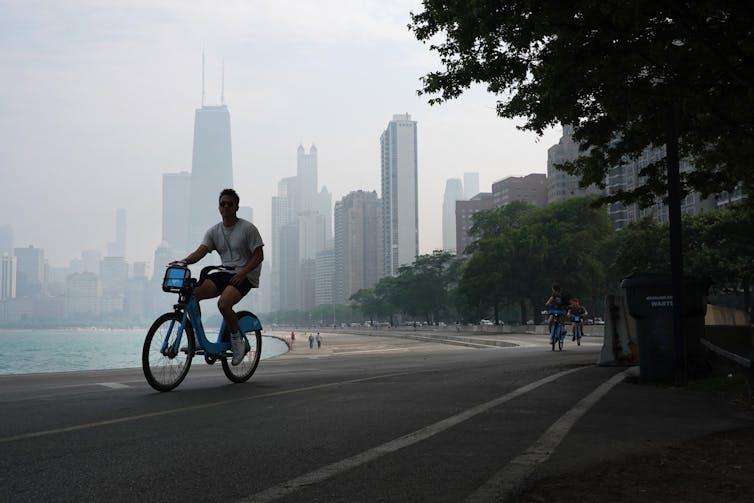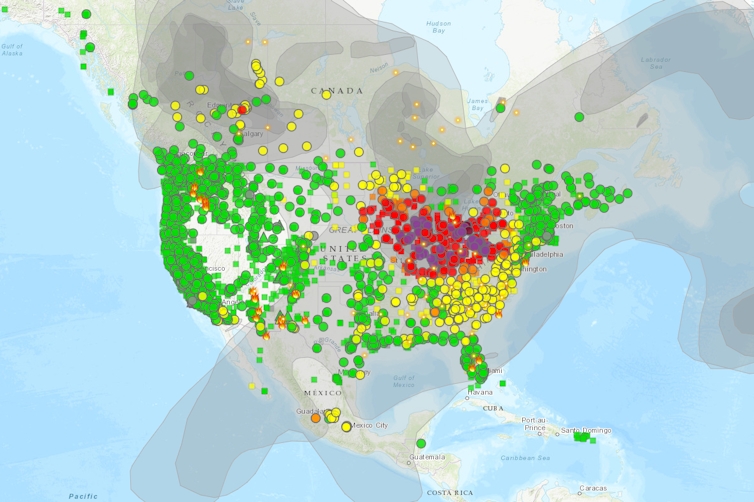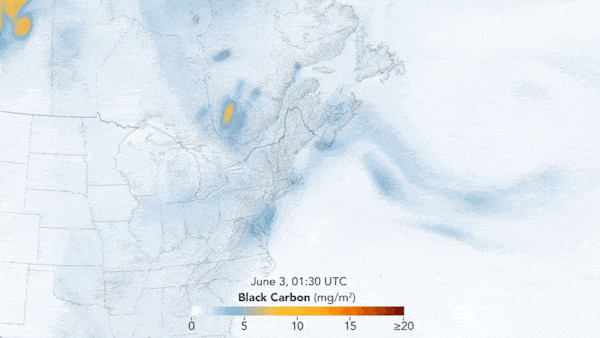The summer of wildfire smoke was only the beginning
(The Conversation) – Canada’s seemingly endless wildfires in 2023 introduced millions of people across North America to the health hazards of wildfire smoke. While Western states have contended with smoky fire seasons for years, the air quality alerts across the U.S. Midwest and Northeast this summer reached levels never seen there before.
The smoke left the air so unhealthy in Philadelphia on June 7, 2023, that the Phillies-Detroit Tigers Major League Baseball game was postponed. That same week, New York City residents hunkered down indoors for several days as a smoky haze hung over the city, turning the skies orange and exposing millions of people to the worst air quality in the world.
Smoke also drifted into the Midwest, triggering the highest air quality index levels in the Chicago area in at least 24 years, forcing the cancellation of numerous summer activities and leaving residents with raspy voices. In several states, people woke up to smoky skies day after day.

The pressing question on many people’s minds: “Is this the new normal?” From our perspective as air quality scientists, we think the answer is likely “yes.”
Global warming means more fires
The wildfire smoke of 2023 highlights an emerging air quality trend. The U.S. had seen decades of falling levels of fine particulate matter pollution, PM2.5, thanks to environmental regulations and cleaner engines, factories and power plants. But wildfires’ contribution to air pollution is increasing again, resulting in flat or rising levels of air pollution in much of the country.
Climate models predicted this reality as global temperatures rise. Hotter, drier conditions, coupled with dry grasses and underbrush that accumulated over decades of fire suppression, have made large wildfires more common. Computer simulations of the future in a warming climate show more smoky days, higher smoke concentrations, larger burned areas and higher emissions – which further fuel climate change.
While prescribed fire and forest thinning can help reduce the number and intensity of fire outbreaks, smoke exposure is still likely to increase because of the increases in burned area anticipated as a result of large-scale shifts in temperature and moisture.
In short, people will need to learn to live with wildfire smoke. It won’t be every year, but we’re likely to see summers like 2023 more often.
Fortunately, there are several tools and strategies for managing a smokier future.
Preparing for smoky days
Managing the risk of wildfire smoke starts with making smart personal choices.
Think of smoke waves like heat waves: They’re easier to face if you’re prepared and know they’re coming. That means paying attention to forecasts and having face masks, air monitors and clean-air shelters available.
Inhaling PM2.5 and the chemicals in wildfire smoke can exacerbate asthma, worsen existing respiratory and cardiac problems and leave people more susceptible to respiratory infection. People caring for individuals sensitive to smoke, such as young children and older adults, will need to plan for their needs in particular.

To prepare, read up on the risks and warning signs from public health professionals. Living with wildfire smoke may mean using air filtration devices, wearing N95 or KN95 masks on bad air days, modifying outdoor commuting patterns and activity schedules and changing household ventilation choices.
What schools and communities can do
Living with smoke will also require changes to how schools, businesses, apartment buildings and government buildings operate.
Schools can start with setting a threshold for canceling outdoor activities and making sure staff are ready to meet the needs of kids with asthma.
Building managers may need to rethink air filtration and ventilation and deploy air quality sensors. Communities will also need contingency plans for festivals and recreation venues, as well as rules for business to protect outdoor workers.
Decisions on how to deal with smoke can be complicated. For example, selecting an air purifier can be a daunting task, with over 900 products on the market. The effectiveness of different smoke management interventions are not well known and can vary depending on small implementation details, such as how a mask fits the wearer’s face, whether exterior doors and windows seal tightly and whether filters are installed properly and are replaced often enough.
Improving smoke monitoring and forecasting
The U.S. has an extensive air quality monitoring and forecasting system to help provide some early warning. It uses ground-based air quality monitors, satellite remote sensing systems to detect smoke and fires and computer systems that tie observations together with wind, chemistry and weather. These are supplemented by expert guidance from meteorologists.

However, for average people trying to make decisions about the safety of outdoor activities, the current forecasting system is wanting. This is especially true when smoke blows in from fires far away, or when rapidly changing smoke emission rates and complex wind patterns lead to conflicting forecasts and advisories.
A few key improvements would go a long way for practical decision making around wildfire smoke, like whether to delay the start of soccer practice:
- Knowledge of how fires evolve hour by hour can improve the smoke estimates going into the forecast models.
- Providing smoke forecasts at neighborhood scale can better inform individuals and cities of pending risks.
- More accurate 10-day forecasts would allow communities to plan.
- Merging seasonal weather forecasts of precipitation, humidity and winds with satellite assessments of fuel conditions could enhance emergency planning for firefighters to help anticipate which regions and periods present the highest risks of fire and smoke.

Maintaining a strong air quality monitoring network is also important. State and local government agencies have reduced the number of ground monitors by about 10% from its peak in 2001. Smoke estimates from satellites and low-cost portable sensors can help, but they work best when they can be cross-calibrated to a well-maintained network of high-accuracy monitors.
We still have a lot to learn
More effective adaptations to smoke will require more research to better understand the factors that make some people more vulnerable to harm from smoke, the effects of cumulative impacts of exposures to environmental stressors and smoke over the life span, and the efficacy and cost-effectiveness of adaptations.
For example, clean-air shelters – the equivalent to a cooling center during extreme heat – are gaining attention, but there is only limited guidance on what constitutes a clean-air shelter and where and when they would be used. A 2023 Government Accountability Office report called for better coordination to help target resources where they can be most effective.
Living with smoke is emerging as a new reality. Next-generation tools need to be both clear and resilient to the compound hazards that develop when smoke hits simultaneously with other challenges, such as extreme heat.










